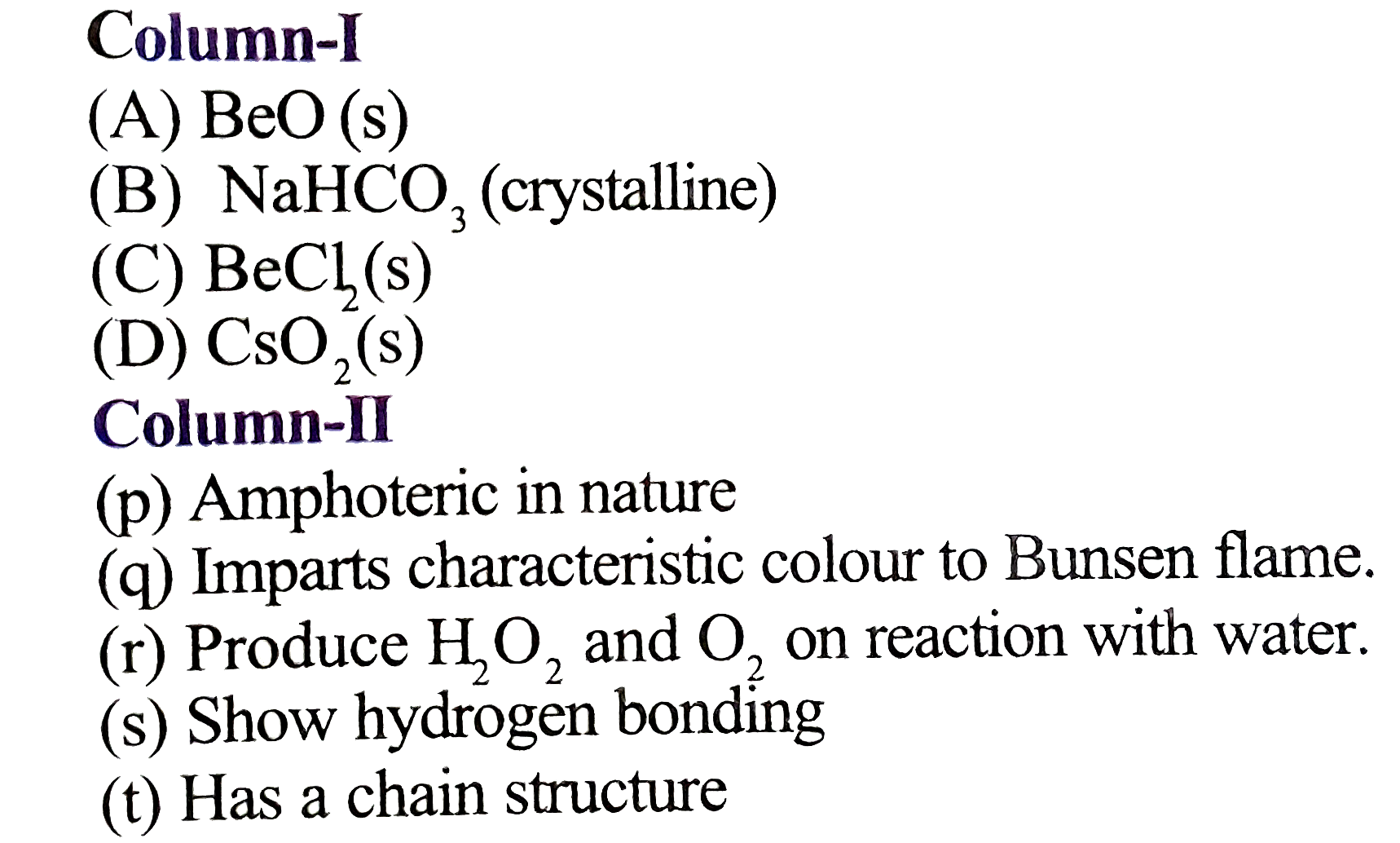Match the nature of aqueous solutions of the substances listed in Column I with the character listed in Column II.
Column IColumn II(A)KCN(aq)(p)Strongly basic(B)TiOH(aq)(q)Neutral(C)BeCl2(aq)(r)Weakly basic(D)NaNO3(aq)(s)Weakly acidic
The correct Answer is:A, B, C, D
To solve the problem of matching the nature of aqueous solutions of the substances listed in Column I with the characteristics listed in Column II, we will analyze each substance in Column I and determine its behavior in an aqueous solution.
1. Analyzing KCN (Column I, A):
- KCN is a salt formed from a strong base (KOH) and a weak acid (HCN).
- When KCN dissolves in water, it dissociates into K⁺ and CN⁻ ions. The CN⁻ ion can hydrolyze to produce OH⁻ ions, making the solution basic.
- Conclusion: KCN is strongly basic.
- Match: A → p (Strongly basic)
2. Analyzing TiOH (Column I, B):
- TiOH (Titanium hydroxide) is a base.
- It does not completely dissociate in water and is considered a weak base.
- Conclusion: TiOH is weakly basic.
- Match: B → r (Weakly basic)
3. Analyzing BeCl₂ (Column I, C):
- BeCl₂ is a salt formed from a weak base (Be(OH)₂) and a strong acid (HCl).
- In aqueous solution, BeCl₂ can hydrolyze to produce H⁺ ions, leading to a slightly acidic solution.
- Conclusion: BeCl₂ is weakly acidic.
- Match: C → s (Weakly acidic)
4. Analyzing NaNO₃ (Column I, D):
- NaNO₃ is a salt formed from a strong base (NaOH) and a strong acid (HNO₃).
- It does not hydrolyze in water and results in a neutral solution with a pH of 7.
- Conclusion: NaNO₃ is neutral.
- Match: D → q (Neutral)
Final Matches:
- A → p (Strongly basic)
- B → r (Weakly basic)
- C → s (Weakly acidic)
- D → q (Neutral)
Summary of Matches:
- A (KCN) → p (Strongly basic)
- B (TiOH) → r (Weakly basic)
- C (BeCl₂) → s (Weakly acidic)
- D (NaNO₃) → q (Neutral)
- KCN is a salt formed from a strong base (KOH) and a weak acid (HCN).
- When KCN dissolves in water, it dissociates into K⁺ and CN⁻ ions. The CN⁻ ion can hydrolyze to produce OH⁻ ions, making the solution basic.
- Conclusion: KCN is strongly basic.
- Match: A → p (Strongly basic)
- TiOH (Titanium hydroxide) is a base.
- It does not completely dissociate in water and is considered a weak base.
- Conclusion: TiOH is weakly basic.
- Match: B → r (Weakly basic)
- BeCl₂ is a salt formed from a weak base (Be(OH)₂) and a strong acid (HCl).
- In aqueous solution, BeCl₂ can hydrolyze to produce H⁺ ions, leading to a slightly acidic solution.
- Conclusion: BeCl₂ is weakly acidic.
- Match: C → s (Weakly acidic)
- NaNO₃ is a salt formed from a strong base (NaOH) and a strong acid (HNO₃).
- It does not hydrolyze in water and results in a neutral solution with a pH of 7.
- Conclusion: NaNO₃ is neutral.
- Match: D → q (Neutral)
- A → p (Strongly basic)
- B → r (Weakly basic)
- C → s (Weakly acidic)
- D → q (Neutral)
- A (KCN) → p (Strongly basic)
- B (TiOH) → r (Weakly basic)
- C (BeCl₂) → s (Weakly acidic)
- D (NaNO₃) → q (Neutral)
Topper's Solved these Questions
- CLASSIFICATION OF ELEMENTS AND PERIODIC PROPERTIES BOOK - ERRORLESS CHAPTER - CLASSIFICATION OF ELEMENTS AND PERIODIC PROPERTIES EXERCISE - JEE Section Integer type questions
2 Videos
- CHEMISTRY IN EVERYDAY IN LIFEBOOK - ERRORLESS CHAPTER - CHEMISTRY IN EVERYDAY IN LIFEEXERCISE - Critical Thinking (Objective question )
25 Videos
- COORDINATION CHEMISTRYBOOK - ERRORLESS CHAPTER - COORDINATION CHEMISTRYEXERCISE - JEE(ADVANCED 2018 MORE THAN ONE CHOICE CORRECT ANSWER
1 Videos
Similar Questions
Knowledge Check
Match the reaction listed in coloumn-I with characteristic(s) listed in column-II
 A1−p,q,2−p,q,s,3−r,4−sB1−p,q,2−p,q,r,s,3−r,4−sC1−p,2−p,q,r,s,3−r,4−sD1−p,q,2−q,r,s,3−s,4−r
A1−p,q,2−p,q,s,3−r,4−sB1−p,q,2−p,q,r,s,3−r,4−sC1−p,2−p,q,r,s,3−r,4−sD1−p,q,2−q,r,s,3−s,4−r
Match the products of reactions listed in column-I with their characteristic(s) listed in column-II


View SolutionMatch the following column of precipitate/mass listed in Column I with the reagent (s) listed in Column II:

View SolutionMatch the products of the reactions listed in column-I with the colour of the precipitate(s) listed in column-II

View SolutionMatch the colour of ppt. listed in column-I with the reagent(s) is column-II.

View SolutionMatch the reactions listed in column-I with the characteristic (s) of the products listed in column-II.

View SolutionMatch the conversions in Column I with the type(s) of reaction(s) given in Column II.
Column IColumnIIA.PbS→PbOp.RoastingB.CaCo3→CaOq.CalcinationC.ZnS→Znr.Carbon reductionD.Cu2S→Cus.Self-reduction
View SolutionMatch the colour of precipitate/residue in column-I with the reagent(s) listed in column-II.

View Solution


